Conference Program
9 October 2014
0830 – 0900 Registration. Venue: Building 9, 14/F
Welcome Addresses. Venue: Building 9, 14/F
0900 – 0930 – Dr. Mathana Santiwat President of Bangkok University
– Prof. Rongbin Lee, Director of Knowledge Management and Innovation Research Centre, The
Hong Kong Polytechnic University
– Dr. Vincent Ribiere, Managing Director and Co-Founder, The Institute for Knowledge and
Innovation South-East Asia, Bangkok University
Plenary Keynote Speeches. Venue: Building 9, 14/F
0930 – 1000 Plenary Keynote Speech 1: Collaborative Advantage in a Competitive Environment
Dr. Alex Bennet. Co-Founder and Principal of the Mountain Quest Institute, USA
1000 – 1030 Plenary Keynote Speech 2: Innovative Education Opens Minds, Creates Knowledge and Drives Innovation
Dr. Arthur Shelley. Principle of Intelligent Answers and Senior Industry Fellow of RMIT University
1030 – 1045 Coffee Break (14/F)
Paper Presentation
10:45 – 12:15
Stream A – Knowledge Management in Business. Venue: Room 953, 5/F. Session Chairman: Eric C. K. Cheng
The Role of Knowledge Management In Industrial Marketing – A Longitudinal Study. Stefan Lagrosen
An Experience Sharing for the Application of Knowledge Management in Garment Industries of Hong Kong. Law Bing Lam
A Mapping Analytic Approach to Trace Development of Multi-disciplinary Research Field: The Case on eHealth. Xi Zhang
Stream B – Knowledge Management System. Venue: Room 954, 5/F. Session Chairman: Stefania Mariano
Micro Knowledge Cluster: Competitive Capability Development In Action Through Knowledge Management System In Thailand. Puvanart Keoplang
A Study on Teaching Professionals Satisfaction with Reference to Self Supporting Institution in India
K.Maran
Internal Structures and External Connectedness: Towards a Typology of French Clusters. Patrick Rondé
12:15 – 13:30 Lunch (14/F)
Plenary Keynote Speeches. Venue: 16/F
13:30 – 14:00. Plenary Keynote Speech 3. BigData, AllData, Old Data: Predictive Analytics in a Changing Data Landscape. Dr. Usama Fayyad, Managing Director and Chief Data Offcer of Barclays Bank
14:00 – 14:30 Plenary Keynote Speech 4Knowledge Management, Innovation and Restorative Justice
Dr. Helen Paige
Founder and Director of The Paige Group Australia
14:30 – 14:45 Coffee Break (14/F)
14:45 – 16:15 MAKE Award Forum
Introduction of MAKE Award. Ms Jenny Chan
Programme Manager of Knowledge Management and Innovation Research Centre
The Hong Kong Polytechnic University
From Transactional to Transformational Knowledge Management: The MAKE recipe for Enterprise Success
Dr. Vishnupriya Sengupta. Managing Consultant | India Advisory
Pricewaterhouse Coopers Private Limited KM and Corporate Innovation: What’s the relationship?
Dr. Ricky Tsui. Director of R&D
ARUP KM Initiation and development in a Manufacturing Company
Dr. Percy Chan, Quality and Global Supply Chain Director, GP Batteries International Limited
16:30 Departure to Chao Praya River by Bus
Dinner Cruise
20:30 Return to Rembrant Hotel and BU
10 October 2014
Plenary Keynote Speeches
Venue: 16/F
0900 – 0930 Plenary Keynote Speech 5
Next Generation Knowledge Management: Inter-Organisational Networks and Innovation
Management
Dr. Madan Rao. Editor, KM Chronicles
0930 – 1000 Plenary Keynote Speech 6
Intellectual Capital Research in Japan: Review and Future agenda
Prof. Chitoshi Koga. Professor of Doshisha University
Dr. Jun Yao. Assistant Professor Ritsumeikan University, Japan
1000 – 1030
Plenary Keynote Speech 7
Internet, Cloud Computing, Big Data and its application
Mr. Paul Sun. Director of Cloud Computing of Industrial Technology Research Institute (ITRI)
1030 – 1045 Coffee Break (14/F)
10:45 – 12:45
Paper Presentation
Stream A
Knowledge Management in Education and Government. Venue: Room 953, 5/F
Session Chairman: Arthur Shelley
A Normative Knowledge Management Model for School Development. Eric C. K. Cheng
A Framework of Design of a Knowledge Management System for Improving 21st Century Skills: A Case Study. Paipan Thanalerdsopit
Impact of ‘Practical Learning’ on Student Satisfaction in International Universities. Shrimoyee Sen
Stream B
Knowledge Management in Business Venue: Room 954, 5/F. Session Chairman: Inpong Luanglath
Who Tweets About Technology? Investigating the Role of Twitter in the Diffusion of Technological Information. István Márton Kiss
A Closer Look at Absorptive Capacity: A Case Study of a Financial Organization in the Kingdom of Bahrain. Stefania Mariano
The Contributions of Knowledge Management into a Better Customer Relationship Management: A Proposed Framework. Emad Abu-Shanab
A Tale of Two Cities: Building an Analytic Framework. Paul Hector
Determining the Existence of Knowledge and its Refflection on Production Process. Hanas Cader
Ph.D. Consortium. Venue: Room 956, 5/F
The Knowledge Mobilization Activities Model in Cross Sector Partnerships: Observations from the Dual Excellence Education Program of The German-Thai Chamber of Commerce. Maik Fuellmann
Modeling Haze Management System by Using CommonKADS. Pipatpong Putthavong
A Diagnosis Framework for Preparing Future Workforce in Higher Education. Philippe Vande Wiele
12:45 – 14:00 Lunch (14/F)
Plenary Keynote Speeches. Venue: 16/F
14:00 – 14:30 Plenary Keynote Speech 8
Is It Still Possible to Achieve Technology and Knowledge Based Sustainable Co-Opetitive Advantage in Turbulent Business Environment? Case: Smart Triple Helix Based Specialization Within Renewable Energy Innovations on Macro and Micro Levels
Prof. Josu TakalaProfessor University of Vaasa, Finland
14:30 – 15:00 Plenary Keynote Speech 9
Cloud Computing and Big Data for Supporting Knowledge Work, Innovation and Learning.
Prof. Eric TsuiProfessor and Associate Director, Knowledge Management and Innovation Research Centre, The Hong Kong Polytechnic University
15:00 – 15:15 Coffee Break (14/F)
15:15 – 17:15
Paper Presentation
Stream A
Innovation and Big Data Venue: Room 953, 5/F Session. Chairman: Manasi Shukla
A Literature Review on Intrapreneurship: A Fad Or Fact of Life for Innovative SMEs. Sharn Orchard
Innovation Strategies of New Product Development (NPD). Preecha Chaochotechuang
Quantitative Analysis for Firm’s Competitiveness based on Innovation. Inpong Luanglath
Exploring Potential Beneffts of Big Data in Value Generation in Healthcare Applications. Lugkana Worasinchai
Managing Quality, Knowledge and Innovation for Competitive Advantage. Allan Deacon
Ph.D. Consortium Venue: Room 956, 5/F
Impact of Customer Knowledge Collaboration (CKC) In Product Innovation: Case Study of LeKise Lighting Co., Ltd. Ratvilai Rangsisingpipat
Knowledge Sharing and Organizational Learning in Thai Firms: Investigating the Impact of Gamifcation on Innovation Capability. Voravee Ruengaramrut
17:15 – 17:45 Closing Remarks by Prof. WB Lee and Dr Vincent Ribiere
Announcement of IKMAP 2016 by Prof. Chitoshi Koga
BigData, AllData, Old Data:
Predictive Analytics in a Changing Data Landscape
Outline
• Big Data all around us
• Some of the issues in BigData
• Introduction to Data Mining and Predictive Analytics Over BigData
• Case studies
• Summary and conclusions
What Matters in the Age of Analytics?
1.Being Able to exploit all the data that is available
• not just what you’ve got available
• what you can acquire and use to enhance your actions
2. Proliferating analytics throughout the organization
• make every part of your business smarter
• Actions and not just insights
3. Driving significant business value
• embedding analytics into every area of your business can significantly drive top line revenues and/or bottom line cost efficiencies
Why Big Data?
A new term, with associated “Data Scientist” positions:
• Big Data: is a mix of structured, semi-structured, and unstructured data:
– Typically breaks barriers for traditional RDB storage
– Typically breaks limits of indexing by “rows”
– Typically requires intensive pre-processing before each query to extract “some structure” – usually using Map-Reduce type operations
• Above leads to “messy” situations with no standard recipes or architecture: hence the need for “data scientists”
– conduct “Data Expeditions”
– Discovery and learning on the spot
The 4-V’s of “Big Data”
• Big Data is Characterized by the 3-V’s:
– Volume: larger than “normal” – challenging to load/process
• Expensive to do ETL
• Expensive to figure out how to index and retrieve
• Multiple dimensions that are “key”
– Velocity: Rate of arrival poses real-time constraints on what are typically “batch ETL” operations
• If you fall behind catching up is extremely expensive (replicate very expensive systems)
• Must keep up with rate and service queries on-the-fly
– Variety: Mix of data types and varying degrees of structure
• Non-standard schema
• Lots of BLOB’s and CLOB’s
• DB queries don’t know what to do with semi-structured and unstructured data.
“Classic” Data: e.g. Yahoo! User DNA

How Data Explodes: really big

The Distinction between “Classic Data” and “Big Data” is fast disappearing
• Most real data sets nowadays come with a serious mix of semi-structured and unstructured components:
– Images
– Video
– Text descriptions and news, blogs, etc…
– User and customer commentary
– Reactions on social media: e.g. Twitter is a mix of data anyway
• Using standard transforms, entity extraction, and new generation tools to transform unstructured raw data into semi-structured analyzable data
Text Data: The Big Driver
• We speak of “big data” and the “Variety” in 3-V’s
• Reality: biggest driver of growth of Big Data has been text data
– Most work on analysis of “images” and “video” data has really been reduced to analysis of surrounding text
Nowhere more so than on the internet
• Map-Reduce popularized by Google to address the problem of processing large amounts of text data:
– Many operations with each being a simple operation but done at large scale
– Indexing a full copy of the web
– Frequent re-indexing
Big Data Applications and Uses

Reality Check
So what do technology people worry about these days?
To Hadoop or not to Hadoop?
when to use techniquesrequiring Map-Reduce and grid computing?
• Typically organizations try to use Map-Reduce for everything to do with Big Data
– This is actually very inefficient and often irrational
– Certain operations require specialized storage
• Updating segment memberships over large numbers of users
• Defining new segments on user or usage data
Drivers of Hadoop in Large Enterprises
Cost of Storage
• Fastest growing demand is more storage
• Data in Data Warehouses have traditionally required expensive storage technology:
–$100K per terabyte per year – cost of Teradata storage
– $2.5K per terabyte – much lower per year – cost of Hadoop on commodity storage
Hadoop Use Cases by Data Type

Analysis & Programming Software


Reality: If Storage is Biggest Driver of Hadoop Adoption; What is the next biggest?
ETL
• Replaces expensive licenses
• Much higher performance with lower infrastructure costs (processors, memory)
• Flexibility in changing schema and representation
• Flexibility on taking on unstructured and semi-structured data
• Plus suite of really cool tools…
Turning the three Vs of Big Data into Value
Understand context and content
• What are appropriate actions?
• Is it Ok to associate my brand with this content?
• Is content sad?, happy?, serious?, informative?
Understand community sentiment
• What is the emotion?
• Is it negative or positive?
• What is the health of my brand online?
Understand customer intent?
• What is each individual trying to achieve?
• Can we predict what to do next?
• Critical in cross-sell, personalization, monetization, advertising, etc…
Many Business Uses of Predictive Analytics


Understanding Context
Reality Check
So who is the company we think is best at handling BigData?
The Display Ads Challenge Today




NetSeer: Intent for Display
Currently Processing 4 Billion Impressions per Day

Problem: Hard to Understand User Intent

Yahoo! – One of Largest Destinations on the Web
80% of the U.S. Internet population uses Yahoo!
– Over 600 million users per month globally!
Global network of content, commerce, media, search and access products
100+ properties including mail, TV, news, shopping, finance, autos, travel, games, movies, health, etc.
25+ terabytes of data collected each day
• Representing 1000’s of cataloged consumer behaviors
Data is used to develop content, consumer, category and campaign insights for our key content partners and large advertisers
More people visited Yahoo! in the past month than:
• Use coupons
• Vote
• Recycle
• Exercise regularly
• Have children living at home
• Wear sunscreen regularly
Yahoo! Big Data – A league of its own…
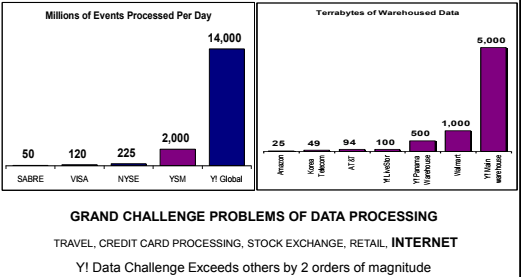
Behavioral Targeting (BT)

Yahoo! User DNA

How it works | Network + Interests + Modelling

Recency Matters, So Does Intensity
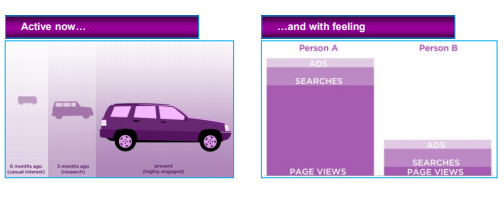
Differentiation | Category specific modelling
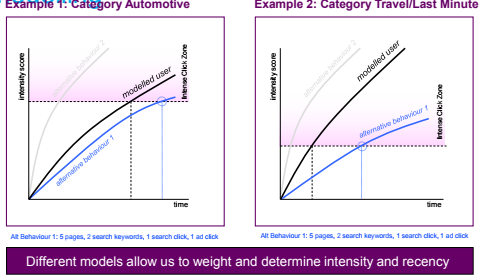
Differentiation | Category specific modelling
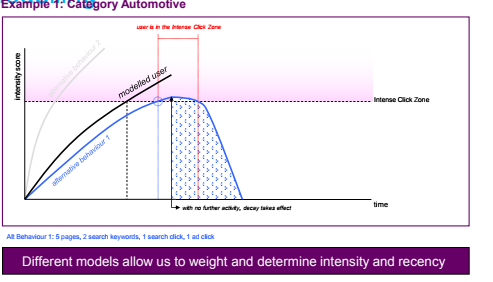
Automobile Purchase Intender Example
A test ad-campaign with a major Euro automobile manufacturer
Designed a test that served the same ad creative to test and control groups on Yahoo
Success metric: performing specific actions on Jaguar website
Test results: 900% conversion lift vs. control group
Purchase Intenders were 9 times more likely to configure a vehicle, request a price quote or locate a dealer than consumers in the control group
~3x higher click through rates vs. control group
Mortgage Intender Example
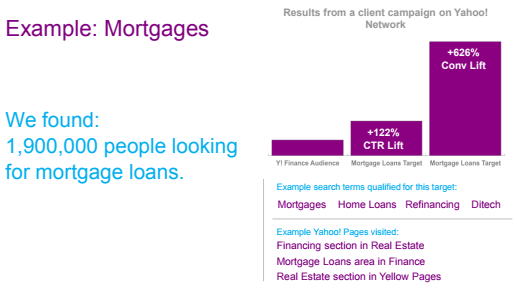
Experience summary at Yahoo!
• Dealing with one of the largest data sources (25 Terabyte per day)
• Behavioral Targeting business was grown from $20M to > $400M in 3 years of investment!
• Yahoo! Specific? — BigData critical to operations
– Ad targeting creates huge value
– Right teams to build technology (3 years of recruiting)
– Search is a BigData problem (but this has moved to mainstream)
Lessons Learned
A lot more data than qualified talent
Finding talent in BigData is very difficult
Retaining talent in BigData is even harder
At Yahoo! we created central group that drove huge value to company
Data people need to feel like they have critical mass
Makes it easier to attract the right people
Makes it easier to retain
Drive data efforts by business need, not by technology priorities
Chief Data Officer role at Yahoo! – now popular
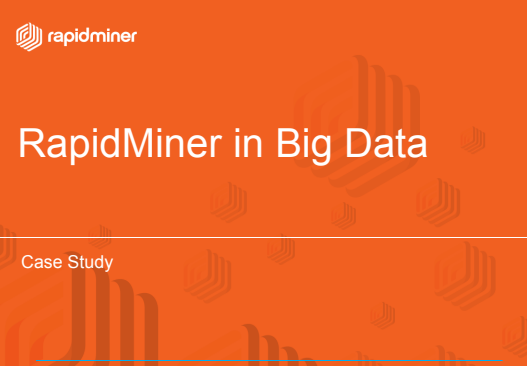
RapidMiner’s Strengths
- Open Source Community & Marketplace – Crowd-sourced innovation,
quality assurance, market awareness. - Fully-integrated Platform – Integrated, process-based business
analytics platform with focus on predictive analytics. - No Programming Required – Easy-to-use, low maintenance costs,
standard platform for business analysts. - Advanced Analytics at Every Scale – In-memory, in-database and in-Hadoop analytics offer best option for every size of database.
- Connectivity – More than 60 connectors (incl. SAP & Hadoop), allowing easy access to structured and unstructured data.
30,000+ Downloads per Month
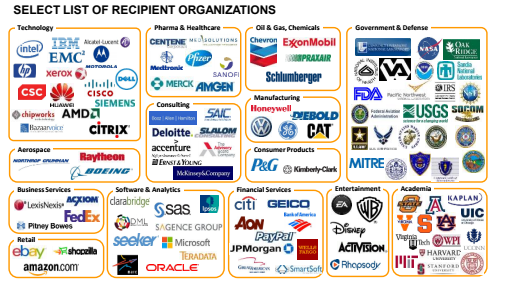
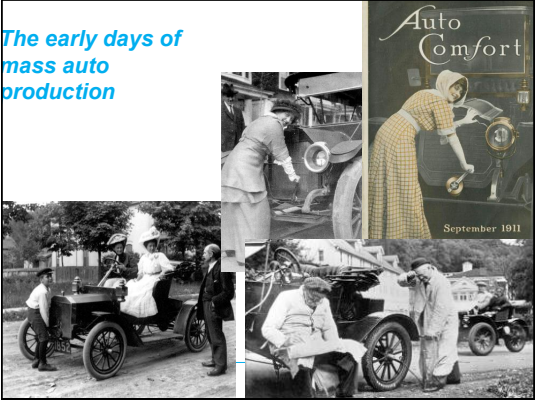
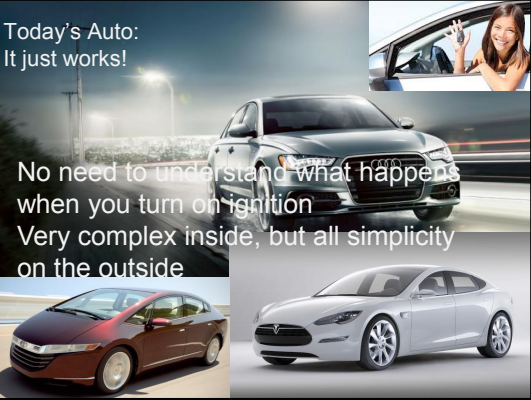
Thank You! & Questions
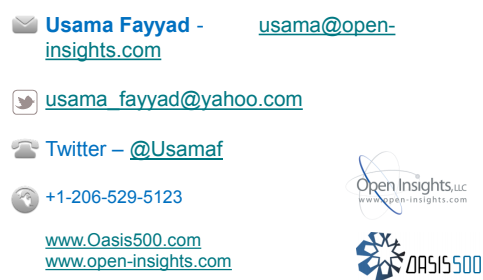
Speakers PDF
Presentation PDF
